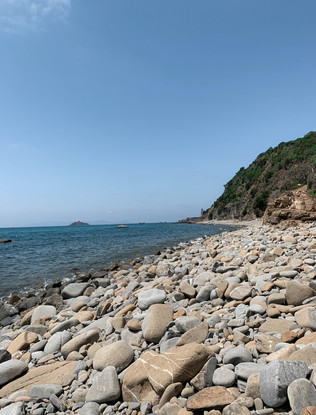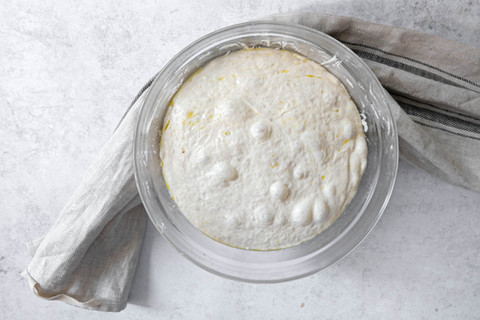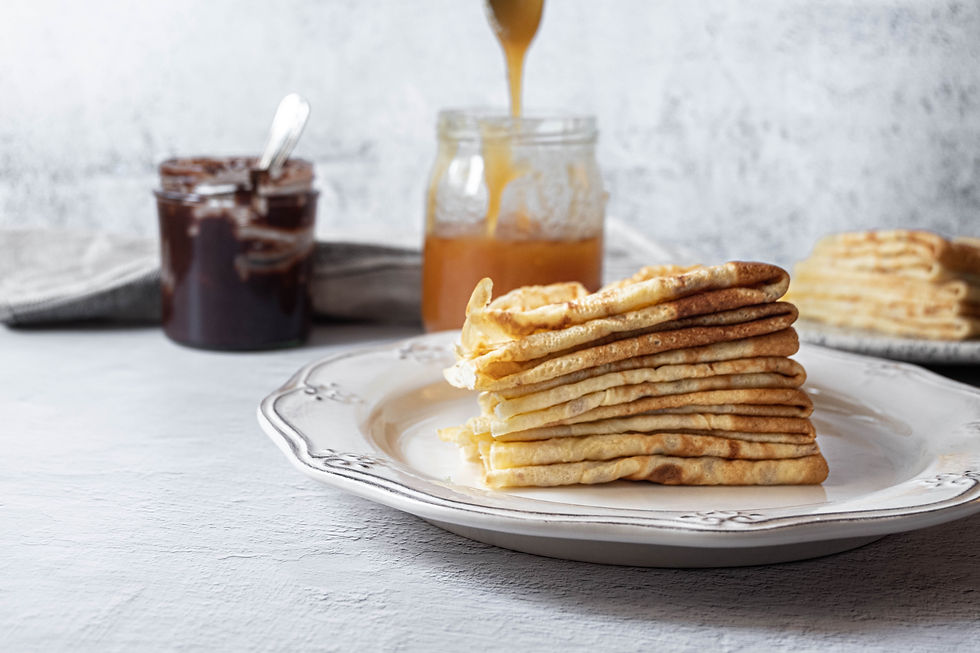Basic Focaccia
- Julia

- Apr 22, 2020
- 6 min read
Updated: Feb 4, 2021
A Focaccia that Will Transport You to Italy
My boyfriend, being a born and raised Milanese, has strong opinions about focaccia - as he should. When I asked him to describe a good one for me, he said, "when you squeeze it, olive oil HAS to ooze out." According to him, and many other golosi Italiani, focaccia has a signature chew that stimulates your whole mouth without being exhaustive, and offers a characteristic punch of briny saltiness resembling that of summer seawater. In fact, my boyfriend eagerly added that focaccia reminds him of summer at the seaside in Tuscany. His favorite way to have it is to sandwich prosciutto cotto and fontina cheese between two pieces of warm focaccia. However, you can have focaccia however you want, with whatever you want on it, and that's the beauty of it.

Punta Ala, Italy. Summer 2019
It was the middle of July. We were laying awkwardly on a shingle beach with burning pebbles pressing onto our back. The sound of the mediterranean sea crashing against the rocks was lulling us to sleep, despite our skin slowly roasting under the prickling sun. After a couple of minutes fighting away the urge to take a nap, I heard a loud growling noise followed by a sharp pain in my stomach - it was 15:30, and we had not had lunch. My boyfriend had promised to take me to a place where they did una focaccia pazzesca, or in English, a fantastic focaccia.
We gathered our things, stuffed them into my super-sized Wayúu bag, and headed to the ocean one last time to get a splash of cool water before heading out. My boyfriend fearlessly plunged into the sea, but I was more hesitant, making my way one rock and the time slipping every now and then on a thin coat of sea moss. I held my breath, thought good thoughts, and hopped into the water as I let out a sharp squeal. We floated unbothered for a couple of minutes until my boyfriend's tummy grumbled in protest, almost like if it was trying to communicate with mine. We listened and waddled out of the water as we stepped on those hot stones once again. We threw on some clothes on top of our wet bathing suits and climbed on top of a bright yellow motorino that my boyfriend had had since he was 16 years old. I tightly buckled my helmet, and we were off.
We arrived at a small bakery hidden on the ground floor of an American style open-air mall, which I thought was odd, given the fact that we were in the middle of Tuscany. Obviously, it was not as colossal as the typical American mall. As I put one foot inside the establishment, I got hit by a hot wave of olive oil infused steam that had escaped from the scorching oven as the baker took out a freshly baked focaccia. I immediately turned my head to signal my boyfriend to order it for us. My eyes were glistening with joy as I followed the baker's every move, from cutting up the bread, sliding it inside a paper bag, dragging it across the counter to ring us up, and finally, placing it in my hands.
Back on the motorino, I had already gobbled a couple of pieces. It was soft, but chewy, and salty, just like the humid coastal air. It was everything my boyfriend had described it to be. But, eating it on the back of the motorino clutching onto him like a leach with the warm wind brushing against my face and olive oil oozing in my mouth was definitely the right way to enjoy it. When we arrived back at the house and got off of the bright yellow scooter, my boyfriend took a quick look at me and realized the focaccia bag was deflated. It was completely empty. There was no sign of warm salty focaccia. Gone. All of it. He looked into my guilty eyes and laughed, "Now we have to go back for some more. These were for dinner."
You can find my recipe below, and maybe, just maybe, if you close your eyes, you will find yourself in the back of a motorino speeding through the tuscan streets while eating a warm piece of focaccia.
(note: focaccia is originally from Liguria, not Tuscany. My connection with it just happened to take place in Punta Ala)
Ingredients

400 g/ml of water
5 g of active dry yeast
10 grams of honey
350 g of All-purpose flour
150 g of bread flour
10 g of salt
20 g of olive oil + 15 g more for oiling the baking sheet and drizzling on top
Flaky salt for sprinkling on top
Method
STEP 1. Mix lukewarm water, yeast, and honey. Let sit for 10-15 minutes. The mixture should look foamy and creamy and should have a strong yeasty smell. If this does not happen for you, your yeast is dead and you need to start over.

STEP 2. In a large bowl, add flours, salt, and yeast water. Combine until no dry spots of flour remain.
STEP 3. Grease a large bowl (that can accommodate the dough when doubled in size) with a generous amount of olive oil - 1/3 of what its called for. Pour the dough into the bowl and move around to coat it in oil. add the rest of the oil on top of the dough and move it around inside the bowl a bit more to make sure the oil is distributed throughout. Its okay if there are pools of oil around the bowl. In fact, thats actually what we're looking for. Cover in plastic wrap or a damp kitchen towel (make sure it does not touch the dough) and let rest for 1 hour in your counter or until doubled in size.
Before resting
After resting
STEP 4. Gently degas dough by running a bench scrapper around the edges of the dough and stretching it while pulling upwards. Cover again in plastic wrap and let rest in the fridge overnight.
STEP 5. Remove form the fridge and let it sit for around 10-15 minutes on your kitchen counter. In the meantime, pour 1/3 of the olive oil called for greasing into the baking pan. Use your hands to make sure the whole of the baking sheet is coated in oil, including the sides. A pool of olive oil will form in the bottom of the baking sheet - again, this is desired. Transfer the dough into the baking sheet by "pouring" it from the bowl into the baking sheet. Let sit near a warm spot to proof until it looks puffy and has increased in size, not necessarily doubled. It can take anywhere from 30 minutes to 1 hour, depending on the temperature of your kitchen. At this point, if you poke the dough with your finger, it should spring back a little bit very slowly. While its proofing, preheat your oven to 230° C / 450° F.
After resting overnight in the fridge

STEP 6. If your focaccia has not spread out to fill your whole baking sheet, carefully coax it with your OILED hands into all corners. Then, still with oiled hands, aggressively poke the dough all over with your fingers to achieve dimples throughout it. Don't be shy, you want to poke the dough all the way through. Drizzle with remaining olive oil and sprinkle some flaky salt. Transfer into the oven on a rack positioned in the middle of the oven and bake for 20 - 30 minutes or until golden brown.

STEP 7. Once out of the oven, drizzle withe more olive oil and transfer to cooling rack


Notes on the Recipe
For this recipe, the best quality olive oil you can get your hands on is optimal. Focaccia is an olive oil enriched dough, which means that is what you will taste - Similarly, to brioche: good butter makes for a good brioche - good oil makes for good focaccia.
I provided measurements for the olive oil to lay out some guidelines. However, you can adjust the amounts for greasing the pan and drizzling to your liking - and by your liking I mean more olive oil. Like I mentioned above, focaccia is all about the olive oil, so, to some extent, there is no such thing as too much oil. Added it (very) liberally when coating the pan, when drizzling on top before and after dimpling, and after it has come out of the oven.
You can top this focaccia with almost anything you can think of: raw or caramelized onions, raw or sun-dried tomatoes, cheese, potato, herbs... the list goes on. Don't be afraid to experiment, try it all!
This focaccia is best when eaten the same day. You can store left overs in a plastic bag to keep it from going stale and dry, or you can pre cut it and freeze it. Toast before eating.




























Comentários